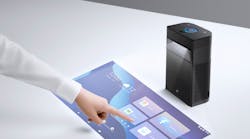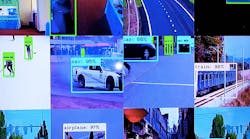This article originally appeared in the April 2020 issue of Security Business magazine. When sharing, don’t forget to mention @SecBusinessMag!
While I didn’t have the opportunity to attend this year’s annual Consumer Electronics Show (CES) in Las Vegas, I read with interest Security Business Editor-in-Chief Paul Rothman’s recap of his personal show highlights in the February issue of the magazine.
One area mentioned that caught my interest was Augmented Reality (AR). It got me thinking about my own limited experience in a related technology – Virtual Reality (VR) – when I donned a headset and took a virtual ride on the Emirates Team New Zealand Americas Cup racing yacht. Not only was it breathtaking, but it also made me happy to know that my feet were firmly planted on dry ground. These are powerful technologies to be sure, and there will be opportunities to deploy them to good use in our industry.
AR and VR Defined
Augmented Reality combines digital 2D or 3D elements (text, images, audio) with real-world environments to enhance or enrich the user experience. For example, Google Sky Maps (www.google.com/sky) overlays celestial information on a smart device pointed at the night sky to help people like me understand what they are really looking at besides the moon.
Wikitude AR (http://wikitude.com) apps allow functionality that can recognize, track and augment images, objects, scenes and geographical locations.
While augmented reality enhances a real-world environment with textual or sensory information, virtual reality completely replaces the user's real-world environment with a simulated one – your brain and consciousness are temporarily placed and immersed in a different world.
Applying it to Security
Training and simulation is an obvious application area for these technologies. Jerry Wilkins of Active Risk Survival (http://activerisksurvival.com) – a passionate advocate of preparedness for unanticipated hostile events – says VR is already being used in first responder training.
“VR puts attendees ‘in the moment’ when getting their heads in the game can be difficult,” Wilkins explains. “You need to get their heartrate up and the adrenaline going.”
Wilkins shares that measurement of biometric data – such as heartrate and respiration – during exercises as a reflection of stress level and an indicator of potential need for further training to build stress tolerance. He further notes that VR is a very cost-effective training solution, with the ability to increase training throughput in a very small footprint area compared to the space requirements of live training exercises.
While preparation for a hostile event is an obvious application, another is familiarization of guards with the facility and optimization of guard tours. ARES Security Corp., (http://aressecuritycorp.com) offers a suite of products based on creating a “digital twin” of a facility – which are 3D models incorporating structure, interior and exterior features, and active and passive barriers and detection tools. Their Virtual Reality Training product enables training exercises to be conducted within the context of a realistic representation of that facility, according to Ben Eazzetta, the company’s CEO. This product, along with ARES Virtual tabletop, enables multiple simulations to be conducted, realistically and cost effectively.
Visualization is another area where AR and VR are beginning to take hold. Think about design, where already, Building Information Modeling software packages such as REVIT bring in multiple elements to make the design process more effective by highlighting potential areas of conflict and a better sense of how pieces fit together.
Adding AR enables 3D blueprints or elements to be superimposed pre-construction over properties and workspaces to help all involved in the construction process better visualize how things will come together.
An actual example is found in Christchurch, New Zealand with an application called CityViewAR, developed by the University of Canterbury, which is based on an Android AR platform that uses the GPS and compass sensors of mobile phones to enable virtual information to be overlaid on live video of the real world. It enables city planners and engineers to see the pre-earthquake city, visualizing buildings that had been destroyed or demolished.
Installation is an area where AR is already being used in assembly situations to provide step-by-step guidance in real time. Boeing, for example, cut its wiring production time by 25% and reduced error rates using a product called Skylight (http://upskill.io). Further, the company cites an average improvement of 32% when the Skylight application is used with smart glasses.
Think of the potential for a security integrator, whether it is a complex field installation or wiring a customized panel in the shop. Having detailed instructions and images superimposed on the real product on hand can reduce or eliminate errors due to forgotten, misplaced, or out-of-date instructions – not to mention time saved by not having to constantly refer to a document that is not in the field of view of an installer.
Troubleshooting and repair: As part of the CES recap, Rothman mentioned a product called TeamViewer Pilot, which enables remote support with graphics and text imposed on the video screen of a smartphone, where off-site support technicians can provide the on-site tech with detailed notes, explanations, pictures, and drawings overlaid on top of a live image. The video stream from the smart device can be paused to provide a still image for annotation. This is an addition to having a VoIP audio connection if needed.
I encourage you to check out Fortem’s piece on Augmented Reality for Physical Security at http://fortem.com/augmented-reality-for-physical-security, which delves further into the impact that both AR and VR will undoubtedly have on our industry.
“We look at the application possibilities as a continuum – moving from today’s modest situational awareness, to real-time optimization, to fully automated response,” Eazzetta says.
Look for opportunities to try out Augmented and Virtual Reality products – it will change the way you see the world.
Ray Coulombe is Founder and Managing Director of SecuritySpecifiers and the CONSULT Technical Security Symposium. Reach him at [email protected], through LinkedIn at www.linkedin.com/in/raycoulombe or follow him on Twitter, @RayCoulombe.





